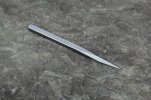- Joined
- Jan 5, 2013
- Messages
- 135
The main issue is that I never found any sprockets that were large/small enough. I remember seeing that first design on eBay a while back, the sprockets he was using were plasma cut in his shop.
In 520 chain (a standard motorcycle chain) there are "stunter sprockets" available up to 70 teeth. A front sprocket can be had with as few as 13 teeth. In addition to the chain reduction, a simple 6:1 belt jackshaft, you could get a 1725 rpm motor down to about 53 RPM at the drum. If you want a slower tumble, get a bigger pulley on the jackshaft. Because the belts are on the fast side, you won't have slippage problems.
And, having a ~200 tooth sprocket waterjet cut out of 1/4" plate at my local vendor would probably cost right around $150. If you're custom making sprockets, you could do fun stuff like elliptical sprockets to oscillate the speed up and down.

